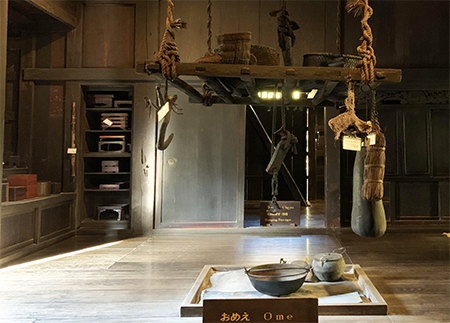

お茶の間探究その2であります(笑)。
住宅の機能仕分けによる「室名」に現代ではお茶の間が見当たらない。
そのわけを考えることは、日本人の住宅史で重要なのではと思う。
お茶の間というのは、ズバリ「囲炉裏空間」だという考え方がある。
上のイラストは吉野ヶ里遺跡で見た上流「大人」〜たいじん〜の家の様子。
支配者側の家族の「竪穴住居」の復元図。
以下説明文。
「部屋の中央に炉があってその周りで食事をします。
奥には神棚やものを置く棚があり、部屋の両脇は床の一段高い寝間で
葦簀(ヨシズ)が下がっています。食器は上質の木器を使います。
炉の上には火棚があって、燻製などを作ります。」
吉野ヶ里は年代的にはAD2世紀〜3世紀だったので、
「クニ」の原型とされている。縄文期が終わって弥生の暮らしが
本格化してきた生活文化・歴史痕跡とされている。
床面は土間で、土座暮らしである様子がわかる。
ヨシズが下がっているとされるけれど敷物として敷かれているのではないか?
ちょっと面白いのは「奥には神棚やものを置く棚」というもの。
神棚というのは、あるいはこの時代から神道が意識されていたか?
弥生の時代にあった宗教性というものには興味を惹かれる。
縄文の世であれば、土偶などの土俗性が薫るけれど、
さて全国で一般的な地域開拓神「八百万」が祀られていたか?
さらにやがて「床の間」という空間に至る「格別の場所」という
室内での最高空間意識があったと思われる。
そういえば、アイヌチセにもこのような棚と神聖空間が同様に見られる。
あちらではクマの頭蓋骨などが飾られていたりするけれど、
熊送りという宗教性が室内空間の重要要素になっていた。
一方、下の写真は江戸中期の山形県古民家の囲炉裏端の様子。
18-19世紀ということで1,700-1,800年の時代の遷移があるけれど、
吉野ヶ里のイラストとほぼ似通ったライフスタイルが展開している。
奥の収納部分には立派な木製の膳部が収められているし、
左手には食器に関係する収納が見られている。
そして囲炉裏空間はまことに一家団欒装置であることがわかる。
この時代にはすでに茶の湯は文化として成立しているし、
食事に随伴して喫茶という習慣もあっただろう。
吉野ヶ里にせよ、江戸期山形にせよ、
どちらも「お茶の間」と呼んでふさわしいような空間があると思える。
というか、囲炉裏は人類普遍的にお茶の間であったのだろう。
しかし古民家では「お茶の間」という室名は見当たらない。
きのうこのテーマで書いたら、読者のNさんから、
「集合住宅においてDKやLDKが茶の間にとって代わり、戸建住宅でもその傾向が
続いているものと思う。賃貸も含めて商品としての住宅で「茶の間」という語の持つ
日常感よりも居間・リビングルームという「60年代の米ホームドラマに見る
良きアメリカ的なもの」という語感が勝ったということでは?」とのご意見。
ある意味では正しいだろうなと思えるのですが、
やはり茶の湯と茶室、茶の間、その連関性は奥が深そう・・・。
English version⬇
[Before the tea ceremony, Yoshinogari’s “living room”]
This is part 2 of the Ochanoma quest (laughs).
In modern times, there is no living room in the “room name” based on the functional sorting of houses.
I think it is important to think about that in the history of Japanese housing.
There is an idea that the living room is a “hearth space”.
The illustration above shows the house of the upstream “adult” -Taijin- seen at the Yoshinogari ruins.
A restored map of the “pit-house” of the ruler’s family.
The explanation below.
“There is a furnace in the center of the room and we eat around it.
There is a Kamidana and a shelf to put things in the back, and both sides of the room are sleeping on the floor higher.
The reeds (Yoshizu) are down. Tableware uses high-quality wooden utensils.
There is a fire shelf above the furnace to make smoked foods. ”
Yoshinogari was in the 2nd to 3rd centuries AD, so
It is said to be the prototype of “Kuni”. Yayoi’s life is over after the Jomon period
It is said to be a lifestyle culture that has become full-scale.
The floor is a dirt floor, and you can see how it is living in a clay seat.
It is said that Yoshizu is down, but isn’t it laid as a rug?
A little interesting thing is “a shelf to put things and things in the back”.
Was Shinto conscious of Shinto from this era?
I am fascinated by the religious nature of Yayoi’s time.
In the Jomon period, clay figurines and other earthly qualities are fragrant.
By the way, was “8 million” called Jinushigami enshrined?
And eventually it is a special place that leads to the space called “Tokonoma”
It seems that there was such a spatial consciousness.
By the way, such shelves and sacred spaces can be seen in Ainu Chise as well.
There are bear skulls and so on, but
The religious nature of bear feeding was an important element of the indoor space.
On the other hand, the photo below shows the hearth of an old folk house in Yamagata prefecture in the middle of the Edo period.
There is a transition of 1,700-1,800 years in the 18th and 19th centuries,
A lifestyle that is almost similar to the illustration by Yoshinogari is developing.
The storage part in the back contains a fine wooden set, and
Storage related to tableware can be seen on the left.
And it turns out that the hearth space is really a family-friendly device.
Tea ceremony was already established as a culture in this era,
There would have been a habit of having a coffee shop with meals.
Whether it’s Yoshinogari or Yamagata during the Edo period,
Both of them seem to have a space suitable for calling them “living room”.
Rather, the hearth was probably the living room for all humankind.
However, in an old folk house, the room name “Ochanoma” is not found.
When I wrote on this theme yesterday, from reader N
“DK and LDK have replaced the living room in apartment houses, and this tendency is also the case in detached houses.
I think it continues. The word “living room” has in housing as a product, including rental
Living room / living room rather than everyday feeling “see in the US home drama of the 1960s
Does that mean that the word “good American” has won? Opinion.
I think it’s correct in a sense,
After all, the connection between the tea ceremony, the tea room, and the tea ceremony seems to be deep.
Posted on 4月 27th, 2021 by 三木 奎吾
Filed under: 住宅マーケティング, 日本社会・文化研究







コメントを投稿
「※誹謗中傷や、悪意のある書き込み、営利目的などのコメントを防ぐために、投稿された全てのコメントは一時的に保留されますのでご了承ください。」
You must be logged in to post a comment.